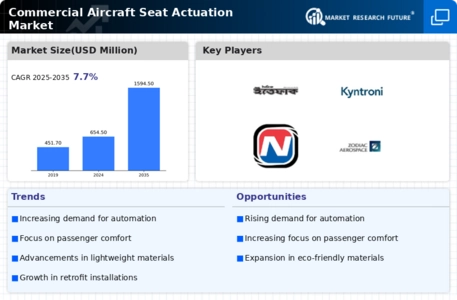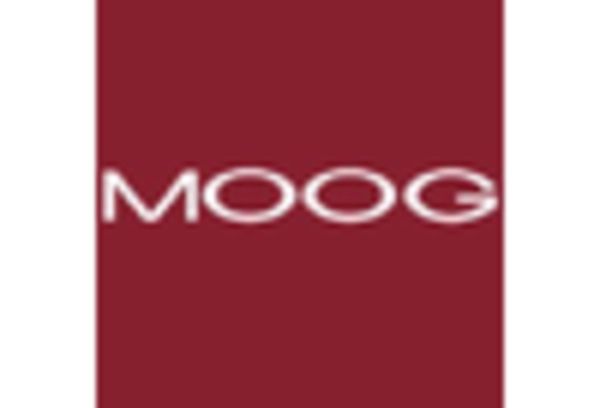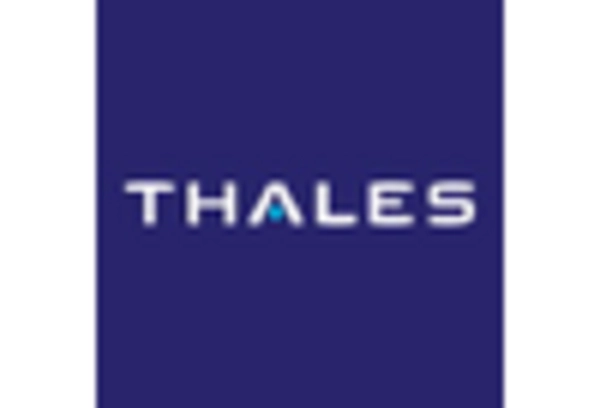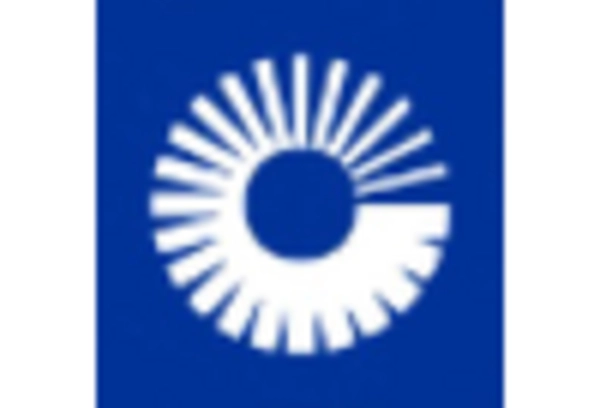-
Executive Summary
-
Market Attractiveness Analysis
- Global Commercial Aircraft Seat Actuation Market, by Actuator Type
- Global Commercial Aircraft Seat Actuation Market, by Seat Class
- Global Commercial Aircraft Seat Actuation Market, by Component
- Global Commercial Aircraft Seat Actuation Market, by Aircraft Type
- Global Commercial Aircraft Seat Actuation Market, by Fit
- Global Commercial Aircraft Seat Actuation Market, by Region
-
Market Introduction
-
Market Definition
-
Scope of the Study
-
Market Structure
-
Key Buying Criteria
-
Market Factor Indicator Analysis
-
Research Methodology
-
Research Process
-
Primary Research
-
Secondary Research
-
Market Size Estimation
-
Forecast Model
-
List of Assumptions
-
Market Insights
-
Market Dynamics
-
Introduction
-
Drivers
- Increase in Passenger Traffic and Subsequent Demand for New Aircraft
- Upgrade of Existing Aircraft
- Drivers Impact Analysis
-
Restraints
-
Opportunities
-
Market/Technological Trends
-
Patent Trends
-
Regulatory Landscape/Standards
-
Market Factor Analysis
-
Value Chain/Supply Chain Analysis
- R&D
- Manufacturing
- Distribution & Sales
- Post-Sales Monitoring
-
Porter’s Five Forces Analysis
- Threat of New Entrants
- Bargaining Power of Buyers
- Threat of Substitutes
- Intensity of Rivalry
- Bargaining Power of Suppliers
-
Global Commercial Aircraft Seat Actuation Market, by Actuator Type
-
Introduction
-
Electro-Mechanical
- Market Estimates & Forecast, 2022-2032
- Market Estimates & Forecast, by Region, 2022-2032
-
Hydraulic
- Market Estimates & Forecast, 2022-2032
- Market Estimates & Forecast, by Region, 2022-2032
-
Pneumatic
- Market Estimates & Forecast, 2022-2032
- Market Estimates & Forecast, by Region, 2022-2032
-
Global Commercial Aircraft Seat Actuation Market, by Seat Class
-
Introduction
-
First Class
- Market Estimates & Forecast, 2022-2032
- Market Estimates & Forecast, by Region, 2022-2032
-
Business Class
- Market Estimates & Forecast, 2022-2032
- Market Estimates & Forecast, by Region, 2022-2032
-
Premium Economy Class
- Market Estimates & Forecast, 2022-2032
- Market Estimates & Forecast, by Region, 2022-2032
-
Economy Class
- Market Estimates & Forecast, 2022-2032
- Market Estimates & Forecast, by Region, 2022-2032
-
Global Commercial Aircraft Seat Actuation Market, by Component
-
Introduction
-
Hardware
- Market Estimates & Forecast, 2022-2032
- Market Estimates & Forecast, by Region, 2022-2032
-
Software
- Market Estimates & Forecast, 2022-2032
- Market Estimates & Forecast, by Region, 2022-2032
-
Global Commercial Aircraft Seat Actuation Market, by Aircraft Type
-
Introduction
-
Narrow Body
- Market Estimates & Forecast, 2022-2032
- Market Estimates & Forecast, by Region, 2022-2032
-
Wide Body
- Market Estimates & Forecast, 2022-2032
- Market Estimates & Forecast, by Region, 2022-2032
-
Global Commercial Aircraft Seat Actuation Market, by Fit
-
Introduction
-
Line-Fit
- Market Estimates & Forecast, 2022-2032
- Market Estimates & Forecast, by Region, 2022-2032
-
Retrofit
- Market Estimates & Forecast, 2022-2032
- Market Estimates & Forecast, by Region, 2022-2032
-
Global Commercial Aircraft Seat Actuation Market, by Region
-
Introduction
-
North America
- Market Estimates & Forecast, by Country, 2022-2032
- Market Estimates & Forecast, by Actuator Type, 2022-2032
- Market Estimates & Forecast, by Seat Class, 2022-2032
- Market Estimates & Forecast, by Component, 2022-2032
- Market Estimates & Forecast, by Fit, 2022-2032
- Market Estimates & Forecast, by Aircraft Type, 2022-2032
- US
- Canada
-
Europe
- Market Estimates & Forecast, by Country, 2022-2032
- Market Estimates & Forecast, by Actuator Type, 2022-2032
- Market Estimates & Forecast, by Seat Class, 2022-2032
- Market Estimates & Forecast, by Component, 2022-2032
- Market Estimates & Forecast, by Fit, 2022-2032
- Market Estimates & Forecast, by Aircraft Type, 2022-2032
- UK
- Germany
- France
- Italy
- Rest of Europe
-
Asia-Pacific
- Market Estimates & Forecast, by Country, 2022-2032
- Market Estimates & Forecast, by Actuator Type, 2022-2032
- Market Estimates & Forecast, by Seat Class, 2022-2032
- Market Estimates & Forecast, by Component, 2022-2032
- Market Estimates & Forecast, by Fit, 2022-2032
- Market Estimates & Forecast, by Aircraft Type, 2022-2032
- China
- Japan
- India
- Australia
- Rest of Asia-Pacific
-
Middle East & Africa
- Market Estimates & Forecast, by Country, 2022-2032
- Market Estimates & Forecast, by Actuator Type, 2022-2032
- Market Estimates & Forecast, by Seat Class, 2022-2032
- Market Estimates & Forecast, by Component, 2022-2032
- Market Estimates & Forecast, by Fit, 2022-2032
- Market Estimates & Forecast, by Aircraft Type, 2022-2032
- Saudi Arabia
- UAE
- Rest of Middle East & Africa
-
Latin America
- Market Estimates & Forecast, by Country, 2022-2032
- Market Estimates & Forecast, by Actuator Type, 2022-2032
- Market Estimates & Forecast, by Seat Class, 2022-2032
- Market Estimates & Forecast, by Component, 2022-2032
- Market Estimates & Forecast, by Fit, 2022-2032
- Market Estimates & Forecast, by Aircraft Type, 2022-2032
- Brazil
- Rest of Latin America
-
Competitive Landscape
-
Competitive Overview
-
Competitor Dashboard
-
Major Growth Strategy in the Global Commercial Aircraft Seat Actuation Market
-
Competitive Benchmarking
-
Market Share Analysis
-
Leading Player in terms of Number of Developments in Global Commercial Aircraft Seat Actuation Market
-
Key Developments & Growth Strategies
- New Product Launch/Service Deployment
- Merger & Acquisition
- Joint Ventures
-
Company Profiles
-
Key Market Players
- AirWorks, Inc.
- Almec EAS Ltd.
- Astronics Corporation
- Bühler Motor GmbH
- Crane Aerospace & Electronics
- ITT Inc.
- Kyntronics
- Mesag-System AG
- Nook Industries, Inc.
- Zodiac Aerospace
-
Appendix
-
References
-
Related Reports
-
List of Abbreviation
-
List of Tables
-
LIST OF ASSUMPTIONS
-
MAJOR PATENTS GRANTED FOR COMMERCIAL AIRCRAFT SEAT ACTUATION (15 MAY 2010–15 MAY 2019)
-
ACTUATOR TYPE: GLOBAL COMMERCIAL AIRCRAFT SEAT ACTUATION MARKET, 2022-2032 (USD MILLION)
-
SEAT CLASS: GLOBAL COMMERCIAL AIRCRAFT SEAT ACTUATION MARKET, 2022-2032 (USD MILLION)
-
COMPONENT: GLOBAL COMMERCIAL AIRCRAFT SEAT ACTUATION MARKET, 2022-2032 (USD MILLION)
-
AIRCRAFT TYPE: GLOBAL COMMERCIAL AIRCRAFT SEAT ACTUATION MARKET, 2022-2032 (USD MILLION)
-
FIT: GLOBAL COMMERCIAL AIRCRAFT SEAT ACTUATION MARKET, 2022-2032 (USD MILLION)
-
GLOBAL COMMERCIAL AIRCRAFT SEAT ACTUATION MARKET, BY REGION, 2022-2032 (USD MILLION)
-
NORTH AMERICA: COMMERCIAL AIRCRAFT SEAT ACTUATION MARKET, BY COUNTRY, 2022-2032 (USD MILLION)
-
NORTH AMERICA: COMMERCIAL AIRCRAFT SEAT ACTUATION MARKET, BY ACTUATOR TYPE, 2022-2032 (USD MILLION)
-
NORTH AMERICA: COMMERCIAL AIRCRAFT SEAT ACTUATION MARKET, BY SEAT CLASS, 2022-2032 (USD MILLION)
-
NORTH AMERICA: COMMERCIAL AIRCRAFT SEAT ACTUATION MARKET, BY COMPONENT, 2022-2032 (USD MILLION)
-
NORTH AMERICA: COMMERCIAL AIRCRAFT SEAT ACTUATION MARKET, BY AIRCRAFT TYPE, 2022-2032 (USD MILLION)
-
NORTH AMERICA: COMMERCIAL AIRCRAFT SEAT ACTUATION MARKET, BY FIT, 2022-2032 (USD MILLION)
-
US: COMMERCIAL AIRCRAFT SEAT ACTUATION MARKET, BY ACTUATOR TYPE, 2022-2032 (USD MILLION)
-
US: COMMERCIAL AIRCRAFT SEAT ACTUATION MARKET, BY SEAT CLASS, 2022-2032 (USD MILLION)
-
US: COMMERCIAL AIRCRAFT SEAT ACTUATION MARKET, BY COMPONENT, 2022-2032 (USD MILLION)
-
US: COMMERCIAL AIRCRAFT SEAT ACTUATION MARKET, BY AIRCRAFT TYPE, 2022-2032 (USD MILLION)
-
US: COMMERCIAL AIRCRAFT SEAT ACTUATION MARKET, BY FIT, 2022-2032 (USD MILLION)
-
CANADA: COMMERCIAL AIRCRAFT SEAT ACTUATION MARKET, BY ACTUATOR TYPE, 2022-2032 (USD MILLION)
-
CANADA: COMMERCIAL AIRCRAFT SEAT ACTUATION MARKET, BY SEAT CLASS, 2022-2032 (USD MILLION)
-
CANADA: COMMERCIAL AIRCRAFT SEAT ACTUATION MARKET, BY COMPONENT, 2022-2032 (USD MILLION)
-
CANADA: COMMERCIAL AIRCRAFT SEAT ACTUATION MARKET, BY AIRCRAFT TYPE, 2022-2032 (USD MILLION)
-
CANADA: COMMERCIAL AIRCRAFT SEAT ACTUATION MARKET, BY FIT, 2022-2032 (USD MILLION)
-
EUROPE: COMMERCIAL AIRCRAFT SEAT ACTUATION MARKET, BY COUNTRY, 2022-2032 (USD MILLION)
-
EUROPE: COMMERCIAL AIRCRAFT SEAT ACTUATION MARKET, BY ACTUATOR TYPE, 2022-2032 (USD MILLION)
-
EUROPE: COMMERCIAL AIRCRAFT SEAT ACTUATION MARKET, BY SEAT CLASS, 2022-2032 (USD MILLION)
-
EUROPE: COMMERCIAL AIRCRAFT SEAT ACTUATION MARKET, BY COMPONENT, 2022-2032 (USD MILLION)
-
EUROPE: COMMERCIAL AIRCRAFT SEAT ACTUATION MARKET, BY AIRCRAFT TYPE, 2022-2032 (USD MILLION)
-
EUROPE: COMMERCIAL AIRCRAFT SEAT ACTUATION MARKET, BY FIT, 2022-2032 (USD MILLION)
-
UK: COMMERCIAL AIRCRAFT SEAT ACTUATION MARKET, BY ACTUATOR TYPE, 2022-2032 (USD MILLION)
-
UK: COMMERCIAL AIRCRAFT SEAT ACTUATION MARKET, BY SEAT CLASS, 2022-2032 (USD MILLION)
-
UK: COMMERCIAL AIRCRAFT SEAT ACTUATION MARKET, BY COMPONENT, 2022-2032 (USD MILLION)
-
UK: COMMERCIAL AIRCRAFT SEAT ACTUATION MARKET, BY AIRCRAFT TYPE, 2022-2032 (USD MILLION)
-
UK: COMMERCIAL AIRCRAFT SEAT ACTUATION MARKET, BY FIT, 2022-2032 (USD MILLION)
-
GERMANY: COMMERCIAL AIRCRAFT SEAT ACTUATION MARKET, BY ACTUATOR TYPE, 2022-2032 (USD MILLION)
-
GERMANY: COMMERCIAL AIRCRAFT SEAT ACTUATION MARKET, BY SEAT CLASS, 2022-2032 (USD MILLION)
-
GERMANY: COMMERCIAL AIRCRAFT SEAT ACTUATION MARKET, BY COMPONENT, 2022-2032 (USD MILLION)
-
GERMANY: COMMERCIAL AIRCRAFT SEAT ACTUATION MARKET, BY AIRCRAFT TYPE, 2022-2032 (USD MILLION)
-
GERMANY: COMMERCIAL AIRCRAFT SEAT ACTUATION MARKET, BY FIT, 2022-2032 (USD MILLION)
-
FRANCE: COMMERCIAL AIRCRAFT SEAT ACTUATION MARKET, BY ACTUATOR TYPE, 2022-2032 (USD MILLION)
-
FRANCE: COMMERCIAL AIRCRAFT SEAT ACTUATION MARKET, BY SEAT CLASS, 2022-2032 (USD MILLION)
-
FRANCE: COMMERCIAL AIRCRAFT SEAT ACTUATION MARKET, BY COMPONENT, 2022-2032 (USD MILLION)
-
FRANCE: COMMERCIAL AIRCRAFT SEAT ACTUATION MARKET, BY AIRCRAFT TYPE, 2022-2032 (USD MILLION)
-
FRANCE: COMMERCIAL AIRCRAFT SEAT ACTUATION MARKET, BY FIT, 2022-2032 (USD MILLION)
-
ITALY: COMMERCIAL AIRCRAFT SEAT ACTUATION MARKET, BY ACTUATOR TYPE, 2022-2032 (USD MILLION)
-
ITALY: COMMERCIAL AIRCRAFT SEAT ACTUATION MARKET, BY SEAT CLASS, 2022-2032 (USD MILLION)
-
ITALY: COMMERCIAL AIRCRAFT SEAT ACTUATION MARKET, BY COMPONENT, 2022-2032 (USD MILLION)
-
ITALY: COMMERCIAL AIRCRAFT SEAT ACTUATION MARKET, BY AIRCRAFT TYPE, 2022-2032 (USD MILLION)
-
ITALY: COMMERCIAL AIRCRAFT SEAT ACTUATION MARKET, BY FIT, 2022-2032 (USD MILLION)
-
REST OF EUROPE: COMMERCIAL AIRCRAFT SEAT ACTUATION MARKET, BY ACTUATOR TYPE, 2022-2032 (USD MILLION)
-
REST OF EUROPE: COMMERCIAL AIRCRAFT SEAT ACTUATION MARKET, BY SEAT CLASS, 2022-2032 (USD MILLION)
-
REST OF EUROPE: COMMERCIAL AIRCRAFT SEAT ACTUATION MARKET, BY COMPONENT, 2022-2032 (USD MILLION)
-
REST OF EUROPE: COMMERCIAL AIRCRAFT SEAT ACTUATION MARKET, BY AIRCRAFT TYPE, 2022-2032 (USD MILLION)
-
REST OF EUROPE: COMMERCIAL AIRCRAFT SEAT ACTUATION MARKET, BY FIT, 2022-2032 (USD MILLION)
-
ASIA-PACIFIC: COMMERCIAL AIRCRAFT SEAT ACTUATION MARKET, BY COUNTRY, 2022-2032 (USD MILLION)
-
ASIA-PACIFIC: COMMERCIAL AIRCRAFT SEAT ACTUATION MARKET, BY ACTUATOR TYPE, 2022-2032 (USD MILLION)
-
ASIA-PACIFIC: COMMERCIAL AIRCRAFT SEAT ACTUATION MARKET, BY SEAT CLASS, 2022-2032 (USD MILLION)
-
ASIA-PACIFIC: COMMERCIAL AIRCRAFT SEAT ACTUATION MARKET, BY COMPONENT, 2022-2032 (USD MILLION)
-
ASIA-PACIFIC: COMMERCIAL AIRCRAFT SEAT ACTUATION MARKET, BY AIRCRAFT TYPE, 2022-2032 (USD MILLION)
-
ASIA-PACIFIC: COMMERCIAL AIRCRAFT SEAT ACTUATION MARKET, BY FIT, 2022-2032 (USD MILLION)
-
CHINA: COMMERCIAL AIRCRAFT SEAT ACTUATION MARKET, BY ACTUATOR TYPE, 2022-2032 (USD MILLION)
-
CHINA: COMMERCIAL AIRCRAFT SEAT ACTUATION MARKET, BY SEAT CLASS, 2022-2032 (USD MILLION)
-
CHINA: COMMERCIAL AIRCRAFT SEAT ACTUATION MARKET, BY COMPONENT, 2022-2032 (USD MILLION)
-
CHINA: COMMERCIAL AIRCRAFT SEAT ACTUATION MARKET, BY AIRCRAFT TYPE, 2022-2032 (USD MILLION)
-
CHINA: COMMERCIAL AIRCRAFT SEAT ACTUATION MARKET, BY FIT, 2022-2032 (USD MILLION)
-
INDIA: COMMERCIAL AIRCRAFT SEAT ACTUATION MARKET, BY ACTUATOR TYPE, 2022-2032 (USD MILLION)
-
INDIA: COMMERCIAL AIRCRAFT SEAT ACTUATION MARKET, BY SEAT CLASS, 2022-2032 (USD MILLION)
-
INDIA: COMMERCIAL AIRCRAFT SEAT ACTUATION MARKET, BY COMPONENT, 2022-2032 (USD MILLION)
-
INDIA: COMMERCIAL AIRCRAFT SEAT ACTUATION MARKET, BY AIRCRAFT TYPE, 2022-2032 (USD MILLION)
-
INDIA: COMMERCIAL AIRCRAFT SEAT ACTUATION MARKET, BY FIT, 2022-2032 (USD MILLION)
-
JAPAN: COMMERCIAL AIRCRAFT SEAT ACTUATION MARKET, BY ACTUATOR TYPE, 2022-2032 (USD MILLION)
-
JAPAN: COMMERCIAL AIRCRAFT SEAT ACTUATION MARKET, BY SEAT CLASS, 2022-2032 (USD MILLION)
-
JAPAN: COMMERCIAL AIRCRAFT SEAT ACTUATION MARKET, BY COMPONENT, 2022-2032 (USD MILLION)
-
JAPAN: COMMERCIAL AIRCRAFT SEAT ACTUATION MARKET, BY AIRCRAFT TYPE, 2022-2032 (USD MILLION)
-
JAPAN: COMMERCIAL AIRCRAFT SEAT ACTUATION MARKET, BY FIT, 2022-2032 (USD MILLION)
-
AUSTRALIA: COMMERCIAL AIRCRAFT SEAT ACTUATION MARKET, BY ACTUATOR TYPE, 2022-2032 (USD MILLION)
-
AUSTRALIA: COMMERCIAL AIRCRAFT SEAT ACTUATION MARKET, BY SEAT CLASS, 2022-2032 (USD MILLION)
-
AUSTRALIA: COMMERCIAL AIRCRAFT SEAT ACTUATION MARKET, BY COMPONENT, 2022-2032 (USD MILLION)
-
AUSTRALIA: COMMERCIAL AIRCRAFT SEAT ACTUATION MARKET, BY AIRCRAFT TYPE, 2022-2032 (USD MILLION)
-
AUSTRALIA: COMMERCIAL AIRCRAFT SEAT ACTUATION MARKET, BY FIT, 2022-2032 (USD MILLION)
-
REST OF ASIA-PACIFIC: COMMERCIAL AIRCRAFT SEAT ACTUATION MARKET, BY ACTUATOR TYPE, 2022-2032 (USD MILLION)
-
REST OF ASIA-PACIFIC: COMMERCIAL AIRCRAFT SEAT ACTUATION MARKET, BY SEAT CLASS, 2022-2032 (USD MILLION)
-
REST OF ASIA-PACIFIC: COMMERCIAL AIRCRAFT SEAT ACTUATION MARKET, BY COMPONENT, 2022-2032 (USD MILLION)
-
REST OF ASIA-PACIFIC: COMMERCIAL AIRCRAFT SEAT ACTUATION MARKET, BY AIRCRAFT TYPE, 2022-2032 (USD MILLION)
-
REST OF ASIA-PACIFIC: COMMERCIAL AIRCRAFT SEAT ACTUATION MARKET, BY FIT, 2022-2032 (USD MILLION)
-
MIDDLE EAST & AFRICA: COMMERCIAL AIRCRAFT SEAT ACTUATION MARKET, BY COUNTRY, 2022-2032 (USD MILLION)
-
MIDDLE EAST & AFRICA: COMMERCIAL AIRCRAFT SEAT ACTUATION MARKET, BY ACTUATOR TYPE, 2022-2032 (USD MILLION)
-
MIDDLE EAST & AFRICA: COMMERCIAL AIRCRAFT SEAT ACTUATION MARKET, BY SEAT CLASS, 2022-2032 (USD MILLION)
-
MIDDLE EAST & AFRICA: COMMERCIAL AIRCRAFT SEAT ACTUATION MARKET, BY COMPONENT, 2022-2032 (USD MILLION)
-
MIDDLE EAST & AFRICA: COMMERCIAL AIRCRAFT SEAT ACTUATION MARKET, BY AIRCRAFT TYPE, 2022-2032 (USD MILLION)
-
MIDDLE EAST & AFRICA: COMMERCIAL AIRCRAFT SEAT ACTUATION MARKET, BY FIT, 2022-2032 (USD MILLION)
-
SAUDI ARABIA: COMMERCIAL AIRCRAFT SEAT ACTUATION MARKET, BY ACTUATOR TYPE, 2022-2032 (USD MILLION)
-
SAUDI ARABIA: COMMERCIAL AIRCRAFT SEAT ACTUATION MARKET, BY SEAT CLASS, 2022-2032 (USD MILLION)
-
SAUDI ARABIA: COMMERCIAL AIRCRAFT SEAT ACTUATION MARKET, BY COMPONENT, 2022-2032 (USD MILLION)
-
SAUDI ARABIA: COMMERCIAL AIRCRAFT SEAT ACTUATION MARKET, BY AIRCRAFT TYPE, 2022-2032 (USD MILLION)
-
SAUDI ARABIA: COMMERCIAL AIRCRAFT SEAT ACTUATION MARKET, BY APPLICATIION, 2022-2032 (USD MILLION)
-
UAE: COMMERCIAL AIRCRAFT SEAT ACTUATION MARKET, BY ACTUATOR TYPE, 2022-2032 (USD MILLION)
-
UAE: COMMERCIAL AIRCRAFT SEAT ACTUATION MARKET, BY SEAT CLASS, 2022-2032 (USD MILLION)
-
UAE: COMMERCIAL AIRCRAFT SEAT ACTUATION MARKET, BY COMPONENT, 2022-2032 (USD MILLION)
-
UAE: COMMERCIAL AIRCRAFT SEAT ACTUATION MARKET, BY AIRCRAFT TYPE, 2022-2032 (USD MILLION)
-
UAE: COMMERCIAL AIRCRAFT SEAT ACTUATION MARKET, BY FIT, 2022-2032 (USD MILLION)
-
REST OF THE MIDDLE EAST & AFRICA: COMMERCIAL AIRCRAFT SEAT ACTUATION MARKET, BY ACTUATOR TYPE, 2022-2032 (USD MILLION)
-
REST OF THE MIDDLE EAST & AFRICA: COMMERCIAL AIRCRAFT SEAT ACTUATION MARKET, BY SEAT CLASS, 2022-2032 (USD MILLION)
-
REST OF THE MIDDLE EAST & AFRICA: COMMERCIAL AIRCRAFT SEAT ACTUATION MARKET, BY COMPONENT, 2022-2032 (USD MILLION)
-
REST OF THE MIDDLE EAST & AFRICA: COMMERCIAL AIRCRAFT SEAT ACTUATION MARKET, BY AIRCRAFT TYPE, 2022-2032 (USD MILLION)
-
REST OF THE MIDDLE EAST & AFRICA: COMMERCIAL AIRCRAFT SEAT ACTUATION MARKET, BY FIT, 2022-2032 (USD MILLION)
-
LATIN AMERICA: COMMERCIAL AIRCRAFT SEAT ACTUATION MARKET, BY COUNTRY, 2022-2032 (USD MILLION)
-
LATIN AMERICA: COMMERCIAL AIRCRAFT SEAT ACTUATION MARKET, BY ACTUATOR TYPE, 2022-2032 (USD MILLION)
-
LATIN AMERICA: COMMERCIAL AIRCRAFT SEAT ACTUATION MARKET, BY SEAT CLASS, 2022-2032 (USD MILLION)
-
LATIN AMERICA: COMMERCIAL AIRCRAFT SEAT ACTUATION MARKET, BY COMPONENT, 2022-2032 (USD MILLION)
-
LATIN AMERICA: COMMERCIAL AIRCRAFT SEAT ACTUATION MARKET, BY AIRCRAFT TYPE, 2022-2032 (USD MILLION)
-
LATIN AMERICA: COMMERCIAL AIRCRAFT SEAT ACTUATION MARKET, BY FIT, 2022-2032 (USD MILLION)
-
BRAZIL: COMMERCIAL AIRCRAFT SEAT ACTUATION MARKET, BY ACTUATOR TYPE, 2022-2032 (USD MILLION)
-
BRAZIL: COMMERCIAL AIRCRAFT SEAT ACTUATION MARKET, BY SEAT CLASS, 2022-2032 (USD MILLION)
-
BRAZIL: COMMERCIAL AIRCRAFT SEAT ACTUATION MARKET, BY COMPONENT, 2022-2032 (USD MILLION)
-
BRAZIL: COMMERCIAL AIRCRAFT SEAT ACTUATION MARKET, BY AIRCRAFT TYPE, 2022-2032 (USD MILLION)
-
BRAZIL: COMMERCIAL AIRCRAFT SEAT ACTUATION MARKET, BY FIT, 2022-2032 (USD MILLION)
-
REST OF LATIN AMERICA: COMMERCIAL AIRCRAFT SEAT ACTUATION MARKET, BY ACTUATOR TYPE, 2022-2032 (USD MILLION)
-
REST OF LATIN AMERICA: COMMERCIAL AIRCRAFT SEAT ACTUATION MARKET, BY SEAT CLASS, 2022-2032 (USD MILLION)
-
REST OF LATIN AMERICA: COMMERCIAL AIRCRAFT SEAT ACTUATION MARKET, BY COMPONENT, 2022-2032 (USD MILLION)
-
REST OF LATIN AMERICA: COMMERCIAL AIRCRAFT SEAT ACTUATION MARKET, BY AIRCRAFT TYPE, 2022-2032 (USD MILLION)
-
REST OF LATIN AMERICA: COMMERCIAL AIRCRAFT SEAT ACTUATION MARKET, BY FIT, 2022-2032 (USD MILLION)
-
THE MOST ACTIVE PLAYERS IN THE GLOBAL COMMERCIAL AIRCRAFT SEAT ACTUATION MARKET
-
CONTRACTS AND AGREEMENTS
-
MERGERS & ACQUISITIONS
-
PRODUCT DEVELOPMENT
-
EXPANSIONS AND INVESTMENTS
-
JOINT VENTURES & PARTNERSHIPS
-
-
List of Figures
-
MARKET SYNOPSIS
-
GLOBAL COMMERCIAL AIRCRAFT SEAT ACTUATION MARKET: MARKET ATTRACTIVENESS ANALYSIS
-
GLOBAL COMMERCIAL AIRCRAFT SEAT ACTUATION MARKET ANALYSIS, BY ACTUATOR TYPE
-
GLOBAL COMMERCIAL AIRCRAFT SEAT ACTUATION MARKET ANALYSIS, BY SEAT CLASS
-
GLOBAL COMMERCIAL AIRCRAFT SEAT ACTUATION MARKET ANALYSIS, BY COMPONENT
-
GLOBAL COMMERCIAL AIRCRAFT SEAT ACTUATION MARKET ANALYSIS, BY AIRCRAFT TYPE
-
GLOBAL COMMERCIAL AIRCRAFT SEAT ACTUATION MARKET ANALYSIS, BY FIT
-
GLOBAL COMMERCIAL AIRCRAFT SEAT ACTUATION MARKET ANALYSIS, BY REGION
-
GLOBAL COMMERCIAL AIRCRAFT SEAT ACTUATION MARKET: MARKET STRUCTURE
-
KEY BUYING CRITERIA FOR COMMERCIAL AIRCRAFT SEAT ACTUATION ACTUATOR TYPES
-
RESEARCH PROCESS OF MRFR
-
NORTH AMERICA: MARKET SIZE & MARKET SHARE, BY COUNTRY, 2020 VS 2030
-
EUROPE: MARKET SIZE & MARKET SHARE, BY COUNTRY, 2020 VS 2030
-
ASIA-PACIFIC: MARKET SIZE & MARKET SHARE, BY COUNTRY, 2020 VS 2030
-
MIDDLE EAST & AFRICA: MARKET SIZE & MARKET SHARE, BY COUNTRY, 2020 VS 2030
-
LATIN AMERICA: MARKET SIZE & MARKET SHARE, BY REGION, 2020 VS 2030
-
MARKET DYNAMICS OVERVIEW
-
DRIVERS IMPACT ANALYSIS: GLOBAL COMMERCIAL AIRCRAFT SEAT ACTUATION MARKET
-
RESTRAINTS IMPACT ANALYSIS: GLOBAL COMMERCIAL AIRCRAFT SEAT ACTUATION MARKET
-
PORTER’S FIVE FORCES ANALYSIS OF THE GLOBAL COMMERCIAL AIRCRAFT SEAT ACTUATION MARKET
-
SUPPLY CHAIN: GLOBAL COMMERCIAL AIRCRAFT SEAT ACTUATION MARKET
-
GLOBAL COMMERCIAL AIRCRAFT SEAT ACTUATION MARKET SHARE, BY ACTUATOR TYPE, 2020 (% SHARE)
-
GLOBAL COMMERCIAL AIRCRAFT SEAT ACTUATION MARKET SHARE, BY SEAT CLASS, 2020 (% SHARE)
-
GLOBAL COMMERCIAL AIRCRAFT SEAT ACTUATION MARKET SHARE, BY COMPONENT, 2020 (% SHARE)
-
GLOBAL COMMERCIAL AIRCRAFT SEAT ACTUATION MARKET SHARE, BY AIRCRAFT TYPE, 2020 (% SHARE)
-
GLOBAL COMMERCIAL AIRCRAFT SEAT ACTUATION MARKET SHARE, BY FIT, 2020 (% SHARE)
-
GLOBAL COMMERCIAL AIRCRAFT SEAT ACTUATION MARKET SHARE, BY REGION, 2020 (% SHARE)
-
NORTH AMERICA: COMMERCIAL AIRCRAFT SEAT ACTUATION MARKET SHARE, BY COUNTRY, 2020 (% SHARE)
-
EUROPE: COMMERCIAL AIRCRAFT SEAT ACTUATION MARKET SHARE, BY COUNTRY, 2020 (% SHARE)
-
ASIA-PACIFIC: COMMERCIAL AIRCRAFT SEAT ACTUATION MARKET SHARE, BY COUNTRY, 2020 (% SHARE)
-
MIDDLE EAST & AFRICA: COMMERCIAL AIRCRAFT SEAT ACTUATION MARKET SHARE, BY COUNTRY, 2020 (% SHARE)
-
LATIN AMERICA: COMMERCIAL AIRCRAFT SEAT ACTUATION MARKET SHARE, BY COUNTRY, 2020 (% SHARE)
-
COMPETITOR DASHBOARD: GLOBAL COMMERCIAL AIRCRAFT SEAT ACTUATION MARKET
-
CAPITAL MARKET RATIO AND FINANCIAL MATRIX
-
CONTRACTS & AGREEMENTS: THE MAJOR STRATEGY ADOPTED BY KEY PLAYERS IN THE GLOBAL COMMERCIAL AIRCRAFT SEAT ACTUATION MARKET
-
BENCHMARKING OF MAJOR COMPETITORS
-
MAJOR MANUFACTURERS MARKET SHARE ANALYSIS, 2020









Leave a Comment